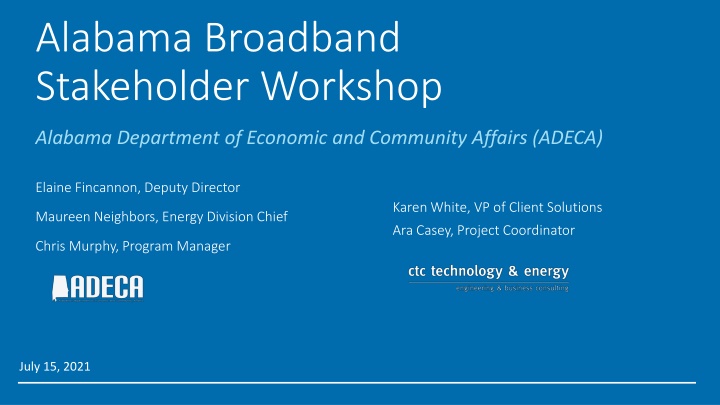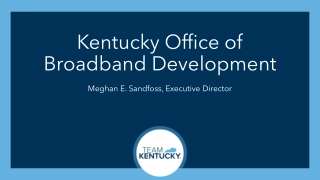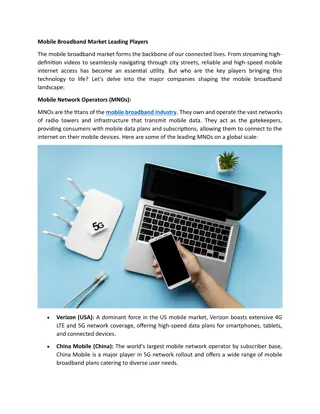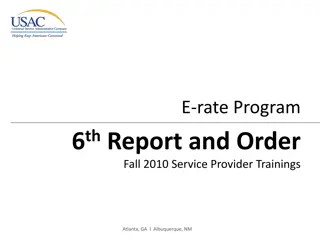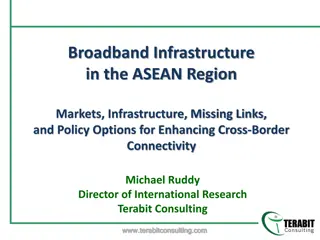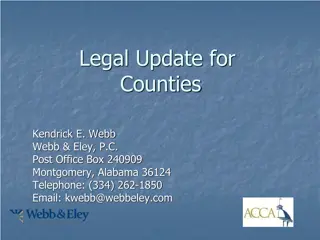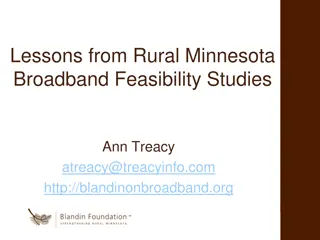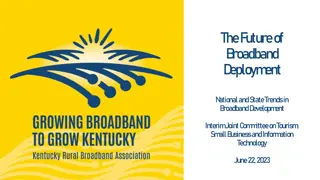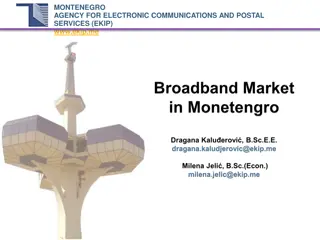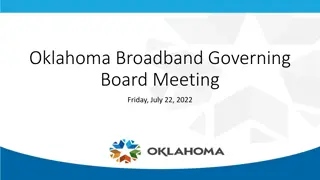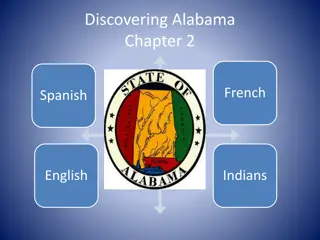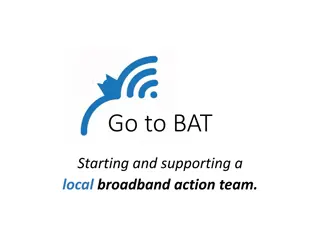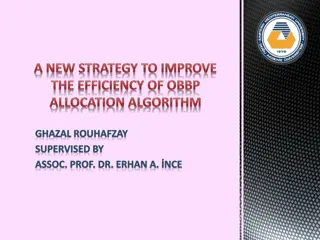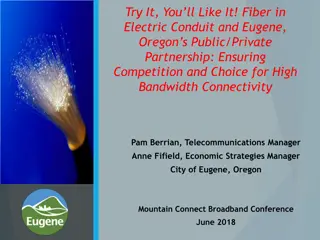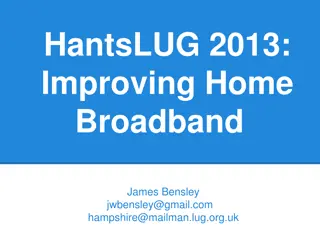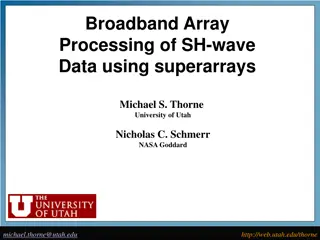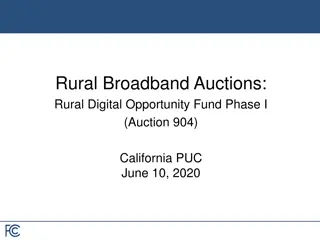Alabama Broadband Stakeholder Workshop Highlights
The Alabama Department of Economic and Community Affairs (ADECA) recently held a stakeholder workshop focused on enhancing broadband accessibility in Alabama. The workshop covered important topics such as ADECA's goals, statewide broadband mapping, stakeholder needs assessment, and federal funding programs. The Office of Broadband Development's history and coordination with federal programs was also discussed, highlighting their crucial role in supporting ISPs applying for broadband deployment funds. The workshop aimed to promote collaboration between stakeholders and public-private partnerships to improve broadband access across the state.
Download Presentation

Please find below an Image/Link to download the presentation.
The content on the website is provided AS IS for your information and personal use only. It may not be sold, licensed, or shared on other websites without obtaining consent from the author.If you encounter any issues during the download, it is possible that the publisher has removed the file from their server.
You are allowed to download the files provided on this website for personal or commercial use, subject to the condition that they are used lawfully. All files are the property of their respective owners.
The content on the website is provided AS IS for your information and personal use only. It may not be sold, licensed, or shared on other websites without obtaining consent from the author.
E N D
Presentation Transcript
Alabama Broadband Stakeholder Workshop Alabama Department of Economic and Community Affairs (ADECA) Elaine Fincannon, Deputy Director Karen White, VP of Client Solutions Maureen Neighbors, Energy Division Chief Ara Casey, Project Coordinator Chris Murphy, Program Manager July 15, 2021
ADECAs Goals ADECA s Goals 1. Provide strategic and technical guidance to Alabama broadband stakeholders and ISPs to develop strategy and potential public- private collaboration 2. Support broadband stakeholders and private partners to understand federal funding programs 3. Provide guidance to compete for federal grants 4. Collect and assess stakeholder and stakeholder community needs to consider in Alabama Statewide Broadband Plan 2
Todays Agenda Today s Agenda Alabama Broadband Accessibility Fund ABC for Students Update Statewide Broadband Mapping Program Stakeholder Broadband Needs Assessment and Community Planning Statewide Broadband Plan
Alabama Office of Broadband Development 4
Office of Broadband Development History Office of Broadband Development History April 2017 Gov. Ivey issued Executive Order 704, establishing ADECA as the agency to assume all powers, duties, responsibilities, authority, and obligations belonging to the Office of Broadband Development March 2018 Gov. Ivey signed the Alabama Broadband Accessibility Act, creating the Alabama Broadband Accessibility Fund May 2019 Gov. Ivey signed Act #2019-327, amending the original Act As of May 2021 $38,236,746.86 in ABAF funds have been awarded to 92 projects. These projects represent approximately 47,460 new services at an average grant cost of $805.66 per service
Office of Broadband Development Office of Broadband Development Coordination with Federal Programs One of the functions of the office is to provide support to ISPs applying for federal funds for broadband deployment This office has developed a process for ISPs applying for USDA ReConnect funds to request a Governor s letter, documentation of the state plan, and expedited approval process This process has allowed many Alabama applicants to be more competitive by receiving bonus points in the applications process Yesterday the office hosted a webinar on current federal funding opportunities
Office of Broadband Development Planning and Mapping In July of 2019, ADECA issued a request for proposals for planning and mapping services Eight responses were received CTC Technology and Energy received the highest score in the evaluation process The contract was reviewed and approved by the Contract Review Committee The amount was $1.5 million, and the contract period is January 1, 2020, through December 31, 2021, The contract was amended to include the ABC for Students program and additional mapping services Additional planning and mapping requirements will be identified through this process the scope of work for phase 2 will be determined as a result of phase 1
Alabama Broadband Accessibility Fund Alabama Broadband Accessibility Fund Funds Speeds Eligible Projects Eligible Areas Eligible Entities Awards of up to $1.5M or 35% of project cost Must provide services of 25/3 Mbps Last Mile Projects, to provide services to residential, business, & institutional end users Unserved with 25/3 broadband & no funding before March 2023 Non- governmental entities that are cooperatives, corporations, LLCs, partnerships, or other private entities Combined with federal funding, cannot exceed 60% of project cost Outside any incorporated city or town with population over 25,000 Middle Mile Projects, to connect other service providers to enable them to reach end users
Alabama Broadband Accessibility Fund Performance Alabama Broadband Accessibility Fund Performance 27 applications were received during the Fiscal Year 2019 application cycles and 15 were awarded 61 applications were received during the Fiscal Year 2020 application cycles and 38 were awarded 41 applications were received during the Fiscal Year 2021 application cycle and 39 were awarded Funds awarded/Expended total $38,156,624.72 with a matching private investment of $83,222,946.29 The average grant dollar cost per new service is $805.66
The Present and Future of the Broadband Accessibility Fund The Present and Future of the Broadband Accessibility Fund No changes to the program at present Next round will be announced in next fiscal year Please sign up for email notifications to receive updated information, application guidelines, and deadlines when they become available The Alabama Broadband Accessibility fund is among the most historically consistent and well-funded grant programs in the region, especially when compared to non-COVID-related grant programs.
ABC for Students Program ABC for Students Program No-Cost Broadband to Low-Income K-12 Students Across State Connected eligible families quickly Included rural families Voucher program stood up in a few weeks Communications tools sent to schools 42 ISPs contracted 100,000 students connected in first 6 weeks Over 200,000 connected by the end of the program Close to 80% were transitioned to the EBB program Rural ISPs made incredible efforts to reach as many families as possible
ABC for Students Program ABC for Students Program Additional Goals and Results Minimized Burden on Schools, Families Promoted Participation by as Many ISPs as Possible Direct to family program Outreach, sign-up events Schools relieved of burden to contact directly to ISPs Partnered to advocate for families and encourage participation Assisted with outreach 42 ISPs participated in the program Promoted Alabama s own economy Single invoicing process for ISPs
Connect Alabama Act of 2021 Creates the Alabama Digital Expansion Authority to oversee broadband expansion Establishes the Alabama Digital Expansion Division within ADECA to develop a statewide connectivity plan Creates the Alabama Digital Expansion Finance Corporation to help fund broadband projects
Statewide Broadband Mapping Program 15
Statewide Broadband Mapping Program Statewide Broadband Mapping Program Goals and Objectives Supports Collaboration with ADECA and Among ISPs Identify Tool for Serving Unserved Areas Unserved Areas Identify the remaining areas lacking 25/3 coverage Identify areas yet to be built using funds from current programs (Alabama and federal) Identify key locations and anchor institutions lacking broadband Help to improve broadband planning efforts Encourage participation by minimizing ISP effort Prepare ISPs for the FCC mapping requests Data sharing by both ADECA and ISPs builds a viable map Help to avoid future conflicts between ISPs and between an ISP and the State or locality
Mapping and Data Efforts Underway Mapping and Data Efforts Underway A Public Facilitation of Private Investment Develop map of broadband availability at every address in Alabama Develop online tools to analyze infrastructure, service coverage, & federal funding Collect reliable & accurate data Map portal will include interactive functionality for the public & local governments Will enable accurate assessment of scale of gaps & precise grant awards Map blends best-in-class commercial, city/county, & ISP data Will be complete in December 2021, several years ahead of federal timeline Includes contributions of local communities, through parcel & 911 from cities & counties Internal map will include proprietary, non-public ISP data for policy-making & grant evaluation Map will require annual, ongoing updates to reflect new federal, state, & private investment Both portals will include tools for analysis & insight to broadband environment Leverages strong collaboration ADECA has developed with ISPs 17
The Statewide Mapping Program The Statewide Mapping Program Will provide useful information to current and potential broadband service providers Will provide useful information that helps local and regional governments understand what they might do to make deployments easier Will allow top-level data to be combined with other data sets, like conduit maps, utility pole and attachment point maps Works hand-in-hand with community efforts Provides address-level granularity, which is universally recognized as the gold standard for broadband connectivity maps (and is not matched by efforts in most of the states we evaluated)
Mapping Program Deliverables Mapping Program Deliverables Website Facilitates access to maps by different entities (ISPs, individuals) for different functions (check for unserved, check federal funding, etc.) Will contain information about the program Additional functionality includes access to forms, challenges Maps Public-facing Internal-facing ISP Data Sharing Agreement and Data Bound by non-disclosure/data sharing agreement between ISPs and ADECA Initial data collection followed by annual or semi-annual updates
Public Public- -Facing Map Facing Map Served and unserved addresses within census blocks A served census block shown Has 80% of addresses within the census block served by 25/3 or better Can be a combination of two of more ISPs within the census block Designates technology - wireline, mobile, fixed wireless, satellite Areas funded by other programs (ADECA Accessibility Program, RDOF, ReConnect, etc.) Anchor institutions No ISP details
Internal Internal- -Facing Map Facing Map All layers in public-facing map ISP detail within census block List of ISPs who serve Highest speed associated with each ISP Latency performance Will be used by ADECA for Policy guidelines Investment decisions
ISP Data Sharing Request Process ISP Data Sharing Request Process Simplified version of what ISPs will be required to submit to the FCC for the Digital Opportunity Data Collection (DODC) program Address-based information ADECA provides the addresses estimated to be within each ISPs service area ISPs provide: Corrected address list (add/delete addresses) Technology type Maximum download speed in Mbps Maximum upload speed in Mbps Whether latency is less than or greater than 100 ms Protected by a Data-Sharing/Non-Disclosure Agreement (DSA)
Data Requested from ISPs Data Requested from ISPs Similar to Current FCC Requirements TechCode - Category of technology for the provision of Internet access service used by the portion of the connection that would terminate at the end-user location (premises). MaxDownload - The maximum download speed in Mbps that is currently available at the specified location or that can be made available at that address within 10 days upon customer request with no additional installation cost to end user MaxUpload - The maximum upload speed in Mbps that is currently available at the specified location or that can be made available at that address within 10 days upon customer request with no additional installation cost to end user Latency100ms - Whether the network round-trip latency associated with each maximum speed combination reported for a particular address is less than or equal to 100 ms, based on the 95th percentile of measurements
TechCode Categories, Plus Mobile Wireless TechCode Categories, Plus Mobile Wireless Same as FCC s Categories, Downstream Technology Cable Modem DOCSIS 1, 1.1 or 2.0 Cable Modem DOCSIS 3.0 Cable Modem DOCSIS 3.1 Cable Modem DOCSIS 4.0 Cable Modem other than DOCSIS 1, 1.1, 2.0, 3.0, 3.1 or 4.0 Optical Carrier / Fiber to the end user (Fiber to the home or business end user, does not include fiber to the curb ) Electric Power Line Satellite Other Asymmetric xDSL ADSL2, ADSL2+ VDSL Symmetric xDSL Other Copper Wireline (all copper- wire based technologies other than xDSL; Ethernet over copper and T-1 are examples) Terrestrial Fixed Wireless Mobile Wireless 4G LTE Mobile Wireless 5G Mobile Wireless - Other
Data Sharing/Non Data Sharing/Non- -Disclosure Agreement Disclosure Agreement Executed by both ISP and ADECA prior to the State s data request submission Voluntary disclosure of data to ADECA Mutual confidentiality ISP will protect address level information and not use address data for any other purpose State will protect address level performance data and ISP company information, and will not use data for any other purpose Defines what will be made public Address-specific information from ISPs will be used for the development, refinement, and maintenance of the Mapping Program
Map Data Location Review and Challenges Map Data Location Review and Challenges Process for both individual and multi-address challenges to map Streamlined method to challenge reported speed data Website will include directions and forms Challenges will be shown on map Burden of proof on challenger and challenged
Location Review / Challenge Process Location Review / Challenge Process Based on FCC s Digital Opportunity Data Collection (DODC) Challenge Process Individual Address or Multi-Address Challenge ADECA Performs Cursory Review 30-Day Period to Address Challenge 30-Day Period to Submit Proof
Location Review / Challenge Process Location Review / Challenge Process Individual Address or Multi-Address Challenge 30-Day Period to Address Challenge ADECA Performs Cursory Review 30-Day Period to Submit Proof Multi-address challenges Complete form Provide info about methods used to identify availability Individual address challenges Complete form Provide evidence of contacting ISP(s) and been denied service at claimed speed (screengrabs, records, etc.)
Location Review / Challenge Process Location Review / Challenge Process Individual Address or Multi-Address Challenge 30-Day Period to Address Challenge ADECA Performs Cursory Review 30-Day Period to Submit Proof Multi-address challenges Complete form on website Provide info about methods used to identify availability Individual address challenges Complete form on website Provide evidence of contacting ISP(s) and been denied service at claimed speed (screengrabs, records, etc.) ADECA Reviews submission for completeness Evaluates merit of challenge Challenger s data must meet minimum burden of proof Notifies challenged ISP Provides challenger and challenged ISP with next steps
Location Review / Challenge Process Location Review / Challenge Process Individual Address or Multi-Address Challenge 30-Day Period to Address Challenge ADECA Performs Cursory Review 30-Day Period to Submit Proof ADECA Reviews submission for completeness Evaluates merit of challenge Challenger s data must meet minimum burden of proof Notifies challenged ISP Provides challenger and challenged ISP with next steps Challenged ISP cooperates with challenger or disputes challenge Challenged ISPs are encouraged to work with challenger Once notified, challenged ISP Has 30 days to respond with an agreed to solution Or the challenge is shown on the map Multi-address challenges Complete form on website Provide info about methods used to identify availability Individual address challenges Complete form on website Provide evidence of contacting ISP(s) and been denied service at claimed speed (screengrabs, records, etc.)
Location Review / Challenge Process Location Review / Challenge Process Individual Address or Multi-Address Challenge 30-Day Period to Address Challenge ADECA Performs Cursory Review 30-Day Period Submit Proof Multi-address challenges Complete form on website Provide info about methods used to identify availability Individual address challenges Complete form on website Provide evidence of contacting ISP(s) and been denied service at claimed speed (screengrabs, records, etc.) ADECA Reviews submission for completeness Evaluates merit of challenge Challenger s data must meet minimum burden of proof Notifies challenged ISP Provides challenger and challenged ISP with next steps Challenged ISP cooperates with challenger or disputes challenger Challenged ISPs are encouraged to work with challenge Once notified, challenged ISP Has 30 days to respond with an agreed to solution Or the challenge replaces prior data Challenged ISP submits proof of its initial service claim; may include Engineering diagrams Network equipment info Proof of service at claimed speeds Confidential elements may include Evidentiary documents Strategic info Some discussions ADECA evaluates and makes decision after 30 days Results incorporated in map
Stakeholder Needs Assessment and Community Planning Statewide Broadband Planning 32
Needs Assessment Needs Assessment - -> Broadband Planning > Broadband Planning Internet Service Providers Interviewed several ISPs about their current networks Services provided, technology, speeds Service area current and planned Funding Technical challenges How can the State help Will continue working with ISPs individually and in a group Have established relationships through ABC for Students 33
Needs Assessment Needs Assessment - -> Broadband Planning > Broadband Planning Individual Broadband Stakeholders Interviewed stakeholders to understand their statewide broadband roles and needs Alabama Supercomputer Authority (pre- and post-COVID for an update) to understand their network and operations ALAHA interviews to examine the unique needs of telehealth AARP to understand the needs of those 50 and older Plan to conduct more individual interviews based on this workshop and community needs 34
Statewide Strategic Planning Underway Statewide Strategic Planning Underway Data Information collected over course of 15 months Data from mapping & existing programs & grants Extensive consultation with ISPs, cooperatives, communities, state agencies Tasks Determine scale of broadband gap and related challenges Estimate cost to fill infrastructure gap under multiple technology scenarios Develop options for public-private collaboration Recommendations Strategy to maximize federal grants to Alabama Framework for State grant program Programmatic solutions for access to devices, training for digital skills 35
Other Current Efforts Other Current Efforts ISPs and Broadband Stakeholders Targeted sessions with ISPs and state broadband stakeholders Informative and information discovery ISP workshop to introduce Mapping Program; sent NDA/data sharing agreement Federal Funding Opportunities webinar yesterday; recorded and available online Statewide Broadband Mapping program review with ISPs This meeting to update you on programs, share tips on collaborating with ISPs, and gather information that will be Captured in the Statewide Broadband Plan And will drive recommendations and action plans
Strategies to Encourage Broadband Expansion Strategies to Encourage Broadband Expansion Technical Strategies Select most future-proof technology feasible Facilitate access to key assets Build and lease fiber assets Build and lease conduit resources Lease facilities space Facilitate underground construction Develop a dig-once policy to promote conduit and fiber constructions Make it future-proof with robust specification and flexibility to add fiber in the future Place conduit banks in congested areas Facilitate aerial construction Work with pole owners to clear space and secure access for new entrants Facilitate construction to and within buildings Availability of conduit from street to building Installation of in-building pathways and cabling
Strategies to Encourage Broadband Expansion Strategies to Encourage Broadband Expansion Information Access Strategies Publish data regarding available conduit, fiber, existing utilities, other assets Make GIS data sets available Create useful maps Document your fiber and conduit assets
Strategies to Encourage Broadband Expansion Strategies to Encourage Broadband Expansion Process Efficiency Strategies Build broadband into planning and staffing Streamline permitting and impaction where possible Provide transparency and predictability regarding permitting and inspection process and timelines Engage ISPs in processes Industry meetings to discuss rules, fees General discussions regarding expansion plans
Steps to a Broadband Strategy Steps to a Broadband Strategy Communities Take Unique Paths, Steps Executed by Community and/or ISP Identify and engage key stakeholders (including ISPs) and identify assets Educate community leaders Assess the current broadband infrastructure and market Risk Evaluate funding options and develop strategic approaches to grant applications and ISP collaboration Benefit Control Evaluate current and future demand for broadband in unserved areas Prepare a high-level design and cost estimate for broadband deployment Prepare a broadband strategy 40
Links to Resources Links to Resources GIGABIT COMMUNITIES - Technical Strategies for Facilitating Public or Private Broadband Construction in Your Community Public Infrastructure/Private Service: A Shared-Risk Partnership Model for 21st Century Broadband Infrastructure Welcome To CLIC s Library On Broadband Public-Private Partnerships Weighing Your Options: An Analysis of Recent Federal Broadband Funding Initial Guidance and Analysis: Treasury Announces Preliminary Guidance for Broadband Projects Funded by the $350B Coronavirus State and Local Fiscal Recovery Funds Developing a Grant Strategy in an Evolving Funding Landscape How Localities Can Monetize Broadband-Enabling Assets and Expand Connectivity
Discovery Can you share your community/region/department s broadband planning. What is your role in broadband? What are your technical challenges? What are your operational challenges? Are there plans for continuing any COVID response initiatives? How can the State help? What are your thoughts about the benefits and challenges of the Accessibility Fund program?
Thank you! Maureen.Neighbors@adeca.alabama.gov kwhite@ctcnet.us A recording of this workshop will be available on the ADECA Broadband Alabama website. https://adeca.alabama.gov/broadband/
Glossary Glossary ISP internet service provider Broadband internet access providing 25 Mbps download speed and 3 Mbps upload speed Served Area/Address a location that has at least one ISP that offers broadband Unserved Area/Address a location that does not have at lease one ISP that offers broadband Wireline Network a network providing communications services using technologies over a fiber strand or cable that is either buried underground or strung aerially Fiber optic Uses bundled fiber optic strands; symmetrical speeds offered up to 2 Gbps DSL Digital subscriber line; uses traditional telco infrastructure; typical fastest download speeds in the 100 Mbps range Cable Uses cable infrastructure; typical fastest download speeds in the 200 Gbps range Fixed Wireless Network a network providing communications services using radio frequency (RF) technologies from an antenna site to one or more fixed locations such as homes or offices Mobile Wireless Network a network providing communications services using radio frequency (RF) technologies from an antenna site to one or more mobile devices
